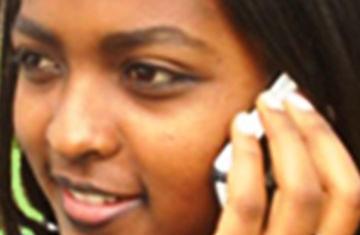
By Samuel Kinde , Tewodros Kidane, and Girum Kifetew
Ethiopia has the world’s lowest number of text messages sent per day, but recent development of the first Ethiopic text messaging (SMS) has inspired texting in widely used scripts, such as Hindi and Chinese.
Two challenges conspired to make mobile communication in Ethiopia, particularly, text messaging (SMS) a late-comer in the world scene. The first challenge is that the Ethiopic writing system (also called Feedel, Fidel or Geez), consists of more than 340 characters. Mapping these characters on a 12-keypad was un-attempted. Overcoming this challenge of displaying Ethiopic characters on any existing cell phone whether from Motorola, Nokia, or Siemens requires some tricky solutions – not impossible; but nonetheless difficult. The second challenge has nothing to do with technology but is a direct result of an unfortunate political environment, where fear of technology forced the country’s telecom company to discontinue even English-language SMS, in this country of 75 million people. This gives Ethiopia the distinction of being the only country in the world where mobile text messaging (SMS) is officially banned.
So, faced with these two challenges, how does one develop a solution that makes Ethiopic SMS a reality right now? The unlikely technical solutions to these two problems are what inspired us – by seeking language commonalities – to extend our work to languages and scripts of more global and market importance.
The solution to the first challenge is to find ways to embed these Ethiopic characters or letters such as 
 into the mobile phone – any mobile phone carried by the majority of mobile phone users inside and outside Ethiopia. This requires developing a technology in processing fonts in some innovative form and uploading them into the mobile phones through various means such as data cable, Bluetooth technology, or through a mobile phone’s web browser. This solution which makes almost all phones in the market become Ethiopic-aware for text messaging purposes by simply downloading a program called FeedelSMS has – we later found out – an interesting implication. As we tested the program on many mobile phones, it became apparent to us and to our technology partners and advisors that the same technology could be used to make any phone in the world – say Hindi-aware , Arabic-aware, or even Chinese-aware. To prove this point, we had to actually learn (by ourselves) the rudimentary basics of the alphabets of some of these languages – particularly Arabic and Hindi. To our utter amazement, it turns out that Hindi (also called Devanagari) falls under the so-called Abugida -
into the mobile phone – any mobile phone carried by the majority of mobile phone users inside and outside Ethiopia. This requires developing a technology in processing fonts in some innovative form and uploading them into the mobile phones through various means such as data cable, Bluetooth technology, or through a mobile phone’s web browser. This solution which makes almost all phones in the market become Ethiopic-aware for text messaging purposes by simply downloading a program called FeedelSMS has – we later found out – an interesting implication. As we tested the program on many mobile phones, it became apparent to us and to our technology partners and advisors that the same technology could be used to make any phone in the world – say Hindi-aware , Arabic-aware, or even Chinese-aware. To prove this point, we had to actually learn (by ourselves) the rudimentary basics of the alphabets of some of these languages – particularly Arabic and Hindi. To our utter amazement, it turns out that Hindi (also called Devanagari) falls under the so-called Abugida -  or syllabic writing system classification just like our own Ethiopic! The linguists define Abugida as a writing system in which consonants are associated with a following vowel as every Ethiopian school kid knows. Lucky for us, almost half-of the world’s scripts like the majority of Indic (Indian) languages, Arabic, Hebrew, etc fall under the Abugida system. To make things more interesting, we learnt that at least some of the Hindi characters are very similar to Ethiopic characters.
or syllabic writing system classification just like our own Ethiopic! The linguists define Abugida as a writing system in which consonants are associated with a following vowel as every Ethiopian school kid knows. Lucky for us, almost half-of the world’s scripts like the majority of Indic (Indian) languages, Arabic, Hebrew, etc fall under the Abugida system. To make things more interesting, we learnt that at least some of the Hindi characters are very similar to Ethiopic characters.
Take the case of the Hindi character ‘क’, for example. If you remove the “hat” on top of this character, you will immediately notice that it is the same as – you have guessed it right – the Ethiopic  .
.
It gets interesting. If you see the other derivatives such as कु = कि =
कि = का =
का = कॅ =
कॅ = Therefore, in a totally unexpected way, our own writing system, Feedel, inspired us to develop a mobile software called HindiSMS in 2006 that can be downloaded to any mobile phone around the world and turn it into – in an instance – a Hindi-aware cell phone. This is not to say that there was no Hindi SMS prior to our product. What it means is that our product fills in a lucrative niche market for consumers who buy cell phones with no pre-installed Hindi fonts.
Therefore, in a totally unexpected way, our own writing system, Feedel, inspired us to develop a mobile software called HindiSMS in 2006 that can be downloaded to any mobile phone around the world and turn it into – in an instance – a Hindi-aware cell phone. This is not to say that there was no Hindi SMS prior to our product. What it means is that our product fills in a lucrative niche market for consumers who buy cell phones with no pre-installed Hindi fonts.
The solution to the second challenge (banned SMS in Ethiopia) also opened up opportunities for us to discover the application of our software in the global mobile market. Faced with this man-made barrier where we can not use Ethiopia’s telecom network to send or receive SMS messages, we came up with a solution that involved buying and configuring our own (cheap) servers that let customers employ mobile data access (called GPRS or EDGE) to exchange SMS messages. This marriage of the traditional wireless network with the mobile internet – it turns out – had numerous advantages that fit very well to the vision of universal SMS – sending SMS to and from anywhere in the world in any desired language. The beauty of this approach – we later understood very clearly – was that it breaks any barrier imposed by carriers knowingly as is the case in Ethiopia or unknowingly. Furthermore, this approach of using a combination of mobile internet with wireless network also flattens the price structure of SMS. In other words, Ethiopic SMS message sent between Addis Ababa and Nazret will cost the same amount as a Chinese SMS sent from Beijing to San Francisco. To our product’s credit, the HindiSMS product developed by our group became the first mobile application to demonstrate the successful sending and receiving of live Hindi SMS message from India to users in the US in October, 2006. In the live test-run, a user in Mumbai, India and a subscriber of AirTel became the first person to ever send & receive a Hindi SMS from a mobile phone in India to a user in California.
Looking back at the progress of the technology in the past year and the steady acceptance of Ethiopic SMS among Ethiopians, and across-border Hindi SMS among Indians, it is with a sense of some satisfaction that we note that the living script, Ethiopic, has been the source of inspiration for a vital and – what some think of as a substantial – contribution to mobile technology.
—–
For more info visit feedelix.com.





























I am very much impressed. Well done Dr Samuel Kinde and friends for making an impact on others. Well done!
Bertu yager jegnoch
Wondimu
Wherever I go to Ethiopia, I need to rent a mobile phone. Is there a place where you can rent a mobile phone?
Impressive!
Why in all the Feedelix information it is never mentioned that the Ethiopic SMS comes from the work of AAU students in 2003/4 ? Come on Feedelix people! Give your credit where credit is due!!
I salute the technological achievements of Samuel, Twodros, and Girum with regard to Ethiopic SMS. This is not the first time for Ethiopian ideas to have an impact beyond its borders. Some 1600 years ago, Ethiopic has inspired the development of an Armenian alphabet, which is a foundation to Armenian identity and culture. I invite wondemochen to visit the African writng systems: http://www.library.cornell.edu/africana/Writing_Systems/Welcome.html
Keep up the good work.
Sorry Ayele, but no applause for intellectual thieves of Feedelix. AAU and GSTIT gets the credit!
This is amazing
How about Geez speech reconginition! Geez is the easiest language for automated speech recognition by which SMS texting would be very simple and effective. Imagin, you talk and a small software captures the voice and look a database of not more than 400 characters and inserts them as text. I don’t think this is difficult for our young scientists. I look forward such applications take root in Ethiopia in two-three years.
it is verry interesting!!!!!!!!!!!!!!!!
This is really wonderful work.
You are also motivating students(like me) specially in this field.
Nice work
Bertu
good job!!!
but it is not invention, try to invent now. the copy is excellent.
that is when you impress the Asians.
engineer ayana biru has desined the typing keys for amaharic and you did the same with the help of soft-ware.
sorry for any inconvenience, i just say the reality.
thanks